Biology > QUESTIONS & ANSWERS > University of PennsylvaniaBIOL 204BIOL 204 (2017) Problem Set 6 + Key (All)
University of PennsylvaniaBIOL 204BIOL 204 (2017) Problem Set 6 + Key
Document Content and Description Below
Biology 204 Spring 2017/REA/ELLIOTT 1 Problem Set 6: β-‐oxidation and oxidative phosphorylation Questions: Note that the questions in blue font will n... ot be graded but have instead been incorporated into this problem set to help you prepare for the final exam. As noted before, it is important that you have a reasonable understanding of what is being asked in the problems and work on them before coming to the discussion. You will need to make use of your lecture notes and the course textbook (or other sources) when attempting to several of these questions, especially those demanding a more integrative approach. 1. Pyruvate carboxylase deficiency is a rare inherited disorder that causes lactic acid and other potentially toxic compounds to reach unusually high levels in the blood. More often than not, this is accompanied by developmental delay and failure to thrive starting in the neonatal or early infantile period. The severity of this autosomal recessive disease ranges from what is deemed ‘type B’, where the neonatal onset of neurological symptoms and lactic acidosis lead to death within months of birth, through ‘type A’, where neurological effects are permanent and those affected die in early childhood but generally survive infancy, to ‘type C’, where sporadic bouts of lactic acidosis occur in an otherwise healthy patient. Pyruvate carboxylase catalyzes a key reaction in gluconeogenesis: the ATPdependent carboxylation of pyruvate to oxaloacetate (pyruvate + HCO3-‐ + ATP ⇌ oxaloacetate + ADP + Pi). As you know, this is an example of an anaplerotic reaction that among other things serves to replenish TCA cycle intermediates. A. Provide another example of an anaplerotic reaction that serves to replenish TCA cycle intermediates and explain why anaplerotic reactions are needed if metabolism is to be sustainable. B. Pyruvate carboxylase is allosterically activated whereas the pyruvate dehydrogenase complex is end-‐product inhibited by acetyl-‐CoA. Explain why is makes good sense metabolically for acetyl-‐CoA to promote the activity of pyruvate carboxylase when the pyruvate dehydrogenase complex is inhibited by the same intermediate. C. After a meal rich in fatty acids and relatively low in carbohydrates, there is a significant increase in the concentration of acetyl-‐CoA. How does allosteric activation of pyruvate carboxylase by acetyl-‐CoA serve to inhibit glycolysis while at the same time increasing the rate of oxidation of acetyl-‐CoA in the TCA cycle? Note that PFK-‐1, which catalyzes the rate-‐limiting step of glycolysis, is allosterically activated by ADP and AMP but allosterically inhibited by ATP and citrate. D. As an attending physician at CHOP you have several children in your care who have a genetic deficiency in pyruvate carboxylase. As a matter of course, these children are treated with continuous intravenous glucose (6-‐9 mg/kg/min) to ensure that they have a constant supply of glucose to minimize the likelihood of hypoglycemia and/or lactic acidosis. However, in an attempt Biology 204 Spring 2017/REA/ELLIOTT 2 to further improve their overall health and quality of life, you augment the glucose drip with infusions of citrate, aspartate and biotin at doses of 3.5 mmol/kg/day, 5 mmol/kg/day and 30 mg/kg/day, respectively. Why did you do this, and how do you think such supplements might improve the prognosis for these children? In thinking about this, appreciate that enzyme deficiencies are not true enzyme knockouts. The enzymes in question are usually present, albeit at lower levels or with lower intrinsic activities than found in normal individuals. 2. A 68 kg (150 lb) adult requires a caloric intake of 2,000 kcal (8,360 kJ) of food per day (every 24 h). The food is metabolized and the free energy is used to synthesize ATP, which then provides energy for the body’s daily chemical and mechanical requirem [Show More]
Last updated: 1 year ago
Preview 1 out of 16 pages
.png)
Reviews( 0 )
Document information
Connected school, study & course
About the document
Uploaded On
May 01, 2021
Number of pages
16
Written in
Additional information
This document has been written for:
Uploaded
May 01, 2021
Downloads
0
Views
21





.png)
.png)










.png)
 Problem Set 4.png)



.png)


.png)


.png)


.png)

.png)
.png)

